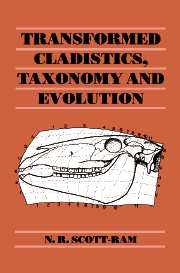Book contents
- Frontmatter
- Contents
- Preface
- Introduction
- PART I ISSUES PERTAINING TO THE PHILOSOPHY OF SCIENCE
- PART II THE STATUS OF THEORETICAL CLASSIFICATIONS
- PART III THE STATUS OF DESCRIPTIVE CLASSIFICATIONS
- 4 Phenetics and the descriptive attitude
- 5 Transformed cladistics and the methodological turn
- 6 Transformed cladistics and evolution
- Notes
- Bibliography
- Author index
- Subject index
5 - Transformed cladistics and the methodological turn
Published online by Cambridge University Press: 21 October 2009
- Frontmatter
- Contents
- Preface
- Introduction
- PART I ISSUES PERTAINING TO THE PHILOSOPHY OF SCIENCE
- PART II THE STATUS OF THEORETICAL CLASSIFICATIONS
- PART III THE STATUS OF DESCRIPTIVE CLASSIFICATIONS
- 4 Phenetics and the descriptive attitude
- 5 Transformed cladistics and the methodological turn
- 6 Transformed cladistics and evolution
- Notes
- Bibliography
- Author index
- Subject index
Summary
Introduction
In 1979 Norman Platnick published a paper entitled ‘Philosophy and the Transformation of Cladistics’ which set out some of the basic principles of the new taxonomic school and their derivation from classical Hennigian cladistics. There followed a flurry of publications, e.g. Nelson & Platnick, Patterson, which attempted to put transformed cladistics on a more secure footing. The fact that transformed cladistics gained the centre stage of the present-day controversy in taxonomy represents a testimony to the success of the enterprise. Quite whether such a standing is justified is questionable. Unfortunatley, the few criticisms that have been levelled at transformed cladistics have either been misguided or misinformed (e.g. Beatty, Charig, Ridley). Further to this, disagreement and misunderstanding have arisen from the transformed cladists' lack of attention to issues that some of the other schools regard as central to any discussion in taxonomy. The need for finding a common ground between transformed cladistics and other schools is therefore important.
Certainly, part of the confusion is a product of the historical development and its similarity of method with phylognetic cladistics. What these similarities are, and where the differences lie must be examined closely since the dividing line between the two is not always explicit. By way of introduction I will first summarise the differences between phylogenetic and transformed cladistics before turning to the procedures that transformed cladists utilise in classification construction.
- Type
- Chapter
- Information
- Transformed Cladistics, Taxonomy and Evolution , pp. 133 - 159Publisher: Cambridge University PressPrint publication year: 1990



